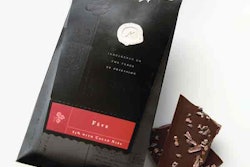
Claimed to be the world’s first sake liqueur, TY KU is a one-of-a-kind product that gives new meaning to a “light” beverage. The jade-colored liquid is lighted up from within whenever the custom 750-mL glass bottle is lifted. The attention-getting secret is in the battery-powered LED light in the base.
The product’s debut in this “limited edition” bottle in early 2007 from TY KU Intl., Manhasset, NY, is the result of literal homework and globetrotting legwork by the company’s cofounders, Kirk Spahn and Trent Ulicny. Its journey to commercialization began with a business class assignment at New York’s Columbia University.
“I had the idea of launching a new kind of health-conscious aphrodisiac liqueur,” recalls Spahn, “and I wanted the packaging to be something that was completely different in all ways.”
After they were awarded an A for their classwork, they continued on for three years and thousands of miles in a global quest for product and package. Their enlightening trek took them to India, China, and Japan. During this time, the duo researched wavelengths, angstroms, refraction, motion sensor technology, environmental restrictions, and packaging.
It all came to commercial fruition with the January launch in Las Vegas. New York distribution was next, followed by planned expansion into five states by fall, Spahn says. Besides bars and nightclubs, TY KU is also sold at retail, including at Albertson’s, and in liquor stores where it sells for about $30.
Although billed as a limited edition bottle via a pressure-sensitive label, every bottle features the patent-pending LED technology in the base that puts it lightyears ahead of anything else out there.
“It’s common for bars and nightclubs to have light disks that stay lit on which liqueur bottles are placed,” Spahn explains. “The idea of our light was to make people notice the product, but not in a ‘cheesy’ way if the light was on the entire time.”
That it turns on only when lifted fit the concept as well as made it practical from a battery power standpoint, according to Spahn.
“Everyone is amazed and curious when they see the glow as the bartender picks it up and pours from it,” he says. After checking on resources stateside, they decided it was more cost-effective to source the product and packaging in Asia. The sake product comes from Japan while package production is done outside Shanghai.
Asian resources
Sourced in China, the frosted screen-printed glass bottle features traditional Asian accents. The pyramid-shaped bottle was ergonomically sculpted so that its angular design fits comfortably in the hand. The shape also lends itself to proper lighting, which is affected by the bottle’s side angles as well as the thickness and quality of the glass. Spahn says the glass is especially thick to yield a bottle that connotes quality.
“It has taken nearly three years to come to market, and a lot of that was because we did the entire packaging, the bottle design, everything from scratch,” says Spahn. “Every part of the bottle was custom-designed for a purpose.”
The base contains the electronics to light the bottle. They consist of an LED inside a sealed membrane sensor that activates when the bottle is lifted. The light is powered by two long-life alkaline button batteries. Ulicny spent three months working in India to make the LED work, but finally gave up and went on to China.
Both the base and the closure are injection-molded of chrome-coated acrylonitrile butadiene styrene (ABS) plastic. The heavy-weight closure features a 100% natural cork insert.
Housing the electronics in this way permits TY KU’s bottle to be recycled because the base can be removed, Spahn points out.
Too costly to do?
Spahn says he and Ulicny were met with skepticism when they began to seriously turn their project from classroom concept to real-world commercialization.
“Our contacts in the United States told us there was no way could this be done—it would be an $80 bottle,” says Spahn. “We wanted it to be economical for a broad range of consumers who thought it was cool to be able to afford it.”
That was not without much work on their part, according to Spahn: “It was very difficult to make it work right. We had so many trial runs.” He says they went through close to 30 different bottle molds.
Yet the base technology, so to speak, was not as difficult as some would think.
“Making it light up is not rocket science,” Spahn notes, “but it’s one of those ideas where people say ‘why the heck didn’t someone think of that already?’”
Others have thought of it, but couldn’t do it, Spahn claims. He says that large companies have spent millions of dollars trying to do what they have done.
He says people are blown away by the result: “There is absolutely nothing like it in the industry.”
The lighting technology, which is patent-pending worldwide, covers lighting a bottle from the bottom, top, or side, Spahn points out. “Anything that attaches to a bottle that makes any kind of illumination, we’ve got it covered.”
It seems that the guys did their homework, start to finish.


























